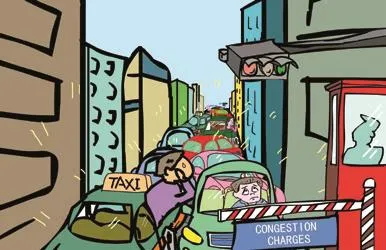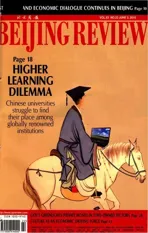Will Congestion Pricing Relieve Traffc Jams?
2010-09-12
Will Congestion Pricing Relieve Traffc Jams?

LI SHIGONG
A recent proposal by Qiu Baoxing, Vice Minister of Housing and Urban-Rural Development, to alleviate Beijing’s traffic jams has triggered heated debate among the public.
Beijing has 20 million people and 4.2 million vehicles, a feet growing by 500,000 each year, Qiu wrote. Since most of the city’s business districts, administrative offices, financial institutions and frst-class hospitals are located in the city center, he warned conventional methods would be insufficient to curb congestion in downtown areas due to explosive growth of traffc fow there.
Besides raising parking fees in city center and improving the management of bus-only lanes, congestion pricing should be introduced, Qiu said. He also suggested scrapping highway tolls to encourage residents in city center to move to satellite cities.
Shi Qixin, professor at the Institute of Transportation Engineering of Beijing-based Tsinghua University, said the international standard for introducing congestion charges was when the degree of saturation of roads reached 85 percent and the average speed of vehicles traveling on roads was below 18 km per hour. Shi said big cities like Beijing were close to that standard.
People opposing the introduction of congestion pricing said the precondition for collecting congestion charges was convenient public transport systems in place. However, Beijing formulated plans to develop a large rail transportation system as recently as 2004 and public transportation in downtown Beijing is still not “convenient.”In these circumstances, levying congestion charges would force some car owners, especially commuters, to switch to public transportation, which could give rise to new problems such as overcrowding on public transportation.
Several cities in China have studied the feasibility of levying congestion charges amid worsening urban traffic jams. But no city has introduced them yet.
Guangzhou, a city in south China, opened public discussion on whether to introduce congestion charges earlier this year. But an online survey conducted by Guangzhou Daily and news portal Sina.com found 84.4 percent of respondents opposed the charges and 5.4 percent could “conditionally support them, depending on where the charge zone is.”
Not a panacea
Lou Yihua (www.qianlong.com): To ease traffic jams, Beijing has banned some vehicles from the road for one day a week based on their plate numbers. This policy has proved effective. Moreover, many car owners have acknowledged the fairness of the policy. But the measure of pulling some cars off roads would outlive its effectiveness in big cities such as Beijing considering the explosive growth of the number of new cars and limited public resources.
If the policy of ordering vehicles off the road according to their plate numbers was revoked and congestion pricing was introduced, the city would have one more revenue source but the traffc congestion wouldn’t be alleviated. Many cars on the roads in Beijing belong to government departments and agencies, which don’t mind paying congestion charges for using their publicly funded cars. The introduction of congestion pricing would only end up forcing some private car owners to switch to public transportation.
Qiu is following the practice started by London. But, after congestion pricing was introduced in 2003, London’s congestion level in 2006 was the same as that of 2003 and serious congestion reappeared in 2009, according to latest statistics. Therefore, congestion pricing might not be the best solution to urban traffc jams in the long run.
Charging car owners fees or limiting the use of cars alone are not sufficient for the management of urban traffc. A mix of measures must be adopted, such as promoting a low-carbon life, reducing the number of publicly funded cars and continuing improving public transport to satisfy people’s demands.
Chun Hua (Modern Express): It seems the proposal to introduce congestion charges and scrap highway tolls aims to lure lowincome residents to move from city proper to suburban areas. Vice Minister Qiu regards congestion pricing as a miracle recipe fortraffic jams and, like many other officials and experts sharing the belief, substantiated its effectiveness with the “pioneering experience” of London.
Why do proponents of congestion pricing keep on bringing forward the “success stories” of London and Singapore? Because they are the only two cities that ever levied congestion charges. There are hundreds of thousands of cities in the world. Can two cities’ practices prove the universality of a policy? Moreover, even London authorities themselves have admitted the congestion charges failed to deliver the expected results.
In China, downtown areas in big cities like Beijing have the best public resources and people are scrambling for them. Compared with paying congestion charges, the costs of moving from the city proper to a satellite city are much higher.
As economic leverage to adjust the traffc fow, congestion pricing shouldn’t be put on the table unless all other possible means to reduce traffic jams have been implemented. For example, what we can do now is to reduce the number of offcial cars and build a public transportation system that is as convenient as that in Singapore. If these two measures are not taken before introducing congestion charges, the government will be blamed for “helping the rich at the cost of the poor.”
Wang Gangyi (Legal Daily): Although the vehicle fleet has been growing along with worsening traffic conditions, it is not the only culprit. We should not blame mostly the owners of private cars. The main cause is urban administration cannot keep up with the speed of urban development. If offcials refuse to be self-critical and fnd solutions inside themselves, their proposals must be onesided and fawed.
The appearance of automobiles acted as a harbinger of modern megacities. As cities expand geographically and demographically, residents will buy and use greater numbers of cars. This has occurred in many cities in other countries. Why haven’t our officials realized this rule and completed urban planning in accordance?
Our city planners have failed to learn from successful urban planning in other countries, such as preserving greater space for future road widening, carefully laying out different function zones and scientifically deciding the mix of different public transport tools. They find themselves faced with the task of addressing chronic traffc jams when it is too late because they have overlooked the root cause of the problem.
A necessary option
Xue Yong (The Beijing News): People critical of congestion pricing said the practice would violate car owners’ private rights. However, it is a wrongly reasoned argument.
Car owners do not possess roads. The essential objective of congestion charges is to limit the use of streets and roads so as to protect public rights. At least, in a market economy society, this is an old legal convention.
Beijing now has 4.2 million vehicles. If every year 500,000 new cars are added to this already huge fleet, within 10 years, Beijing will have 10 million cars. If 4.2 million cars are clogging the city, what will happen to it with 10 million cars? This is a common problem that also plagues other big metropolises such as Shanghai and Guangzhou.
Levying congestion charges in big cities such as Beijing, Shanghai and Guangzhou is only a matter of time. Nowadays, the number of private cars is not too many and a relatively small number of people are affected. In the future, when every family has at least a car, congestion pricing will be more difficult to put into practice as then every family’s interests might be affected to some extent.
Zhong Dong (www.sina.com.cn): A lot of cities are speeding up the construction of subways and light rail as a way to improve traffic conditions, but these infrastructures will not start to work immediately. During these years, car numbers may explode, and cities are already too congested to accept new cars. Thus, congestion charges must be collected when necessary, or the overall urban traffic system will break down and everyone will be affected. And, since the effectiveness of congestion charges is different in different road sections, it’s necessary to diversify charging standards.
It might not be the best idea to levy congestion charges based on realistic conditions in different cities, but it’s better than no policy at all. Policymakers should work out a set of fee-collecting methods to suit different Chinese cities, put them into practice until there is no more traffc congestion and there are enough subways to help divert car fows. If car owners do not make sacrifces, the convenience of those who do not possess cars will be affected. After all, the latter’s interests should be more valued, because this is a refection of social fairness.
Han Zhipeng (Nanfang City News): Congestion pricing is a good idea. First, fees will discourage some motorists from driving on weekdays; second, it will prevent a certain number of vehicles from entering the city center during rush hours. Congestion charges will also discourage people from purchasing cars and curb unnecessary and irrational transport demands. Nowadays, some youngsters buy cars upon graduation. If congestion charges are levied, they will hesitate. In this sense, congestion charges will curb these kinds of premature and excessive consumption.
China’s public traffc system is still underdeveloped. However, congestion charges will force the government to put public traffc frst.
Wen Yujie (www.cnr.cn): Congestion pricing will not necessarily ease traffc jams absolutely, but at least it may help to make the traffc fow smoother.
Let’s imagine, if car owners think the congestion charges are too high, they might cut back on the use of cars and will especially try to avoid crowded areas. They may also frst park their cars handily and then take buses or subways to their destinations.
It’s now high time to levy congestion charges. Take Guangzhou for example. Not all areas can have access to subways due to technical and geological restrictions, so the city can only turn to congestion pricing. Otherwise, do you think they will pull down buildings to make room for further fyovers? If congestion charges are applied in certain areas and for limited periods, the problem of traffc congestion will certainly be solved.
Dear Readers,
“Forum” is a column that provides a space for varying perspectives on contemporary Chinese society. We invite you to submit personal viewpoints on past and current topics (in either English or Chinese). E-mail us at byao@cipg.org.cn Please provide your name and address along with your comments.
